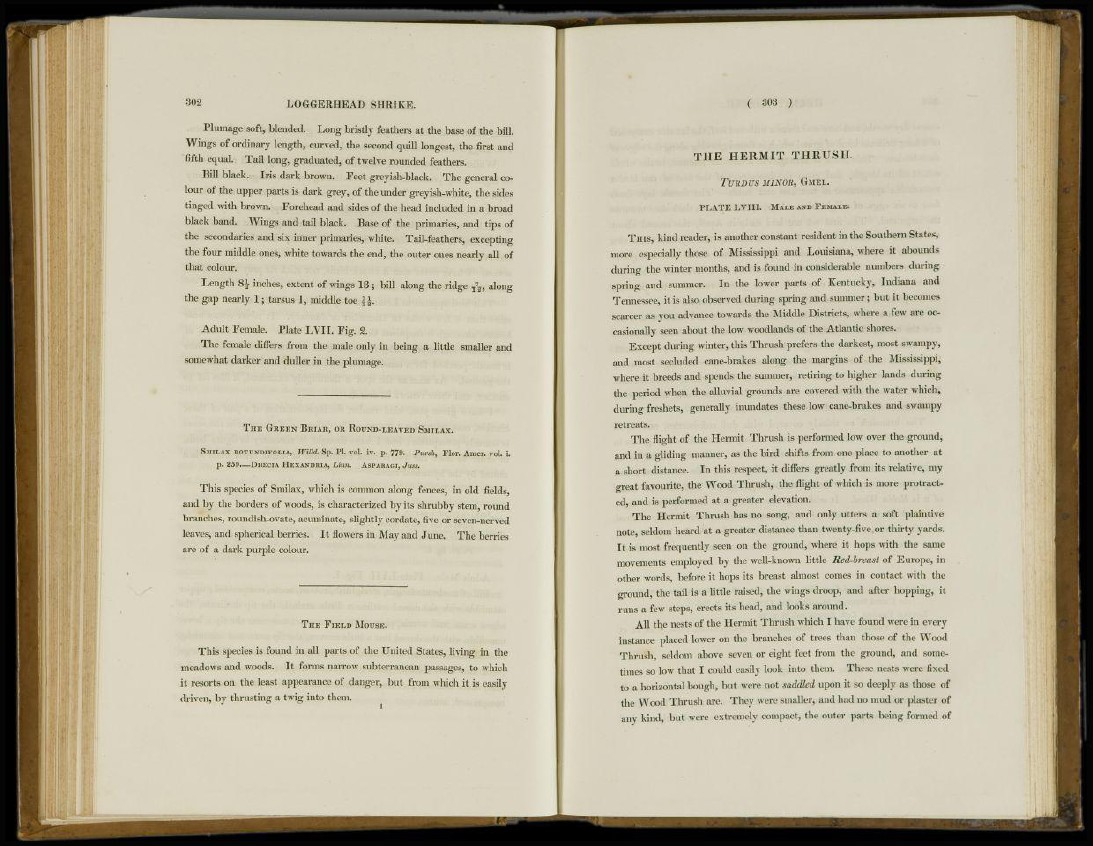
302 L O G G E R H E A D S H R I K E.
Plumage soft, blended. Long bristly feathers at the base of the bill.
Wings of ordinary length, curved, the second quill longest, the first and
fifth equal. Tail long, graduated, of twelve rounded feathers.
Bill black. Iris dark brown. Feet greyish-black. The general colour
of the upper parts is dark grey, of the under greyish-white, the sides
tinged with brown. Forehead and sides of the head included in a broad
black band. Wings and tail black. Base of the primaries, and tips of
the secondaries and six inner primaries, white. Tail-feathers, excepting
the four middle ones, white towards the end, the outer ones nearly all of
that colour.
Length 8^ inches, extent of wings 13 ; bill along the ridge T
7
2 , along
the gap nearly 1; tarsus 1, middle toe \l.
Adult Female. Plate LVII. Fig. 2.
The female differs from the male only in being a little smaller and
somewhat darker and duller in the plumage.
THE GREEN BRIAR, OR ROUND-LEAVED SMILAX.
S M I L A X itOTujjDiFOXiA, Willd. Sp. PL vol. iv. p. 779. Pursh, Flor. Amer. vol. i.
p. 2 5 9 . — D I C E C I A H E X A N D I U A , Linn. ASPARAOT, JUSS.
This species of Smilax, which is common along fences, in old fields,
and by the borders of woods, is characterized by its shrubby stem, round
branches, roundish-ovate, acuminate, slightly cordate, five or seven-nerved
leaves, and spherical berries. It flowers in May and June. The berries
are of a dark purple colour.
THE FIELD MOUSE.
This species is found in all parts of the United States, living in the
meadows and woods. It forms narrow subterranean passages, to which
it resorts on the least appearance of danger, but from which it is easily
driven, by thrusting a twig into them.
( 303 )
T H E H E R M I T THRUSH.
TURDUS MINOR, G . M E L.
P L A T E L V I I I . M A L E A N D F E M A L E .
T H I S , kind reader, is another constant resident in the Southern States,
more especially those of Mississippi and Louisiana, where it abounds
during the winter months, and is found in considerable numbers during
spring and summer. In the lower parts of Kentucky, Indiana and
Tennessee, it is also observed during spring and summer; but it becomes
scarcer as you advance towards the Middle Districts, where a few are occasionally
seen about the low woodlands of the Atlantic shores.
Except during winter, this Thrush prefers the darkest, most swampy,
and most secluded cane-brakes along the margins of the Mississippi,
where it breeds and spends the summer, retiring to higher lands during
the period when the alluvial grounds are covered with the water which,
during freshets, generally inundates these low cane-brakes and swampy
retreats.
The flight of the Hermit Thrush is performed low over the ground,
and in a gliding manner, as the bird shifts from one place to another at
a short distance. In this respect, it differs greatly from its relative, my
great favourite, the Wood Thrush, the flight of which is more protracted,
and is performed at a greater elevation.
The Hermit Thrush has no song, and only utters a soft plaintive
note, seldom heard at a greater distance than twenty-five or thirty yards.
It is most frequently seen on the ground, where it hops with the same
movements employed by the well-known little Red-breast of Europe, in
other words, before it hops its breast almost comes in contact with the
ground, the tail is a little raised, the wings droop, and after hopping, it
runs a few steps, erects its head, and looks around.
All the nests of the Hermit Thrush which I have found were in every
instance placed lower on the branches of trees than those of the Wood
Thrush, seldom above seven or eight feet from the ground, and sometimes
so low that I could easily look into them. These nests were fixed
to a horizontal bough, but were not saddled upon it so deeply as those of
the Wood Thrush are. They were smaller, and had no mud or plaster of
any kind, but were extremely compact, the outer parts being formed of